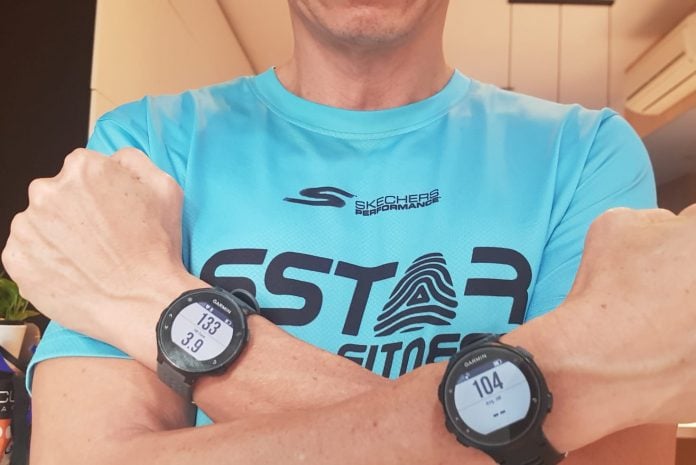I did an experiment and wore two heart rate watches, one on each wrist. See the picture – same human, same brand, at the same time but I got different heart rate readings. The difference is almost 30 beats per minute, which is a gap of a few HR zones! Is HR a reliable way to measure your running intensity? Let’s find out.
Heart rate is a fickle mistress
Heart rate is very sensitive to many external factors like ambient temperate (on a hot day, your HR goes up, even when running at the same intensity), hydration (thirsty and your HR goes up even if you are running at the same speed), stress (feeling excited at the start of a race, and your HR goes up). Lack of sleep, your HR goes up, so you train slower and end up letting your mindset, work, family and social commitments affect your training!
Why? Because we are human
Here’s another key point–when you exercise, the longer you do it, the higher your HR. Called cardiac drift, and it affects beginners to elite runners, all humans. So to maintain your HR zone during runs, you end up going slower and slower, which is not the best way to train and race. As a coach, I have seen runners set higher HR zones for the later part of their race, to maintain an even effort or pace. That seems to be a round-about way of trying to run an even paced race. Why not just set the right pace in the first place and stick to it?
If not heart rate then what?
I am part of a global network of coaches from the Road Runners Clubs of America and the IAAF. When most runners and coaches that I know world-wide train, they use pace, time and distance, matched with the Rate Of Perceived Exertion (RPE) to measure training and racing intensity. RPE is very comprehensive because it takes into account a range of feelings, plus mental and physical inputs like breathing, heart rate, sweating, muscle fatigue, and overall discomfort.
RPE is easy to learn and use
While exertion levels may seem subjective, matching that with a scale makes it accurate and easy to use. At SSTAR.fitness we use the BorgCR10 scale which is widely used in the exercise industry across many sports and activities, from running to resistance training.
Here is what some beginner runners have to say. Eliza Pang who didn’t start running until four months ago, and recently completed a half marathon said ‘’I started training with the rate of perceived exertion method and found it very easy to understand and follow. You simply start by paying attention to how hard you breathe, and how easy you can still talk and run.’’
How to measure exertion with RPE?
Cheryl Chen, who started running 3 times a week, less than three months ago said ‘’ RPE is easy to understand by using a scale of 1 to 10, with 3 being jogging at a pace where I can still talk full sentences, 5 is when I can talk but a few words at time like “I am still feeling ok” and 8 onwards is just one or two words like “keep going” or “a bit more” All my friends who are also beginners find this easy and reliable’’
How do more advanced runners use RPE?
We are all different and there are many ways to train. SSTAR.fitness training programs use both RPE and Heart Rate, to develop training plans based on time, distance and pace that are customized to each athletes fitness level and goals.
Muru, an experienced runner aiming for a Boston qualifier, was following a heart rate training program said “I used to train based on HR but found the training intensity too low. There were too many days that my runs were slower than previous runs. I was running slower, as a result, my races were slower. That wasn’t progress. With a training plan based on pace and realistic race goals, I feel now every run has a purpose, I am building something, towards race day”. He added ‘’ training using a heart rate monitor alone may be holding me back from reaching my full potential’’
Goal setting based on your current fitness level
Setting each training session at the right training intensity and goals is key. At SSTAR.fitness we match RPE with Heart Rate zones using the Karvonen formula, which includes your Resting Heart Rate. that takes your current fitness level into account. More about SSTAR.fitness training zones and this formula in future posts.
Going beyond just RPE, heartrate and intensity
Regardless of whether you are using heart rate or RPE, to measure training intensity, a good training program should also consider the duration, frequency, and the type of training. At SSTAR.fitness we believe in the holistic approach so strongly that we even trademarked it SSTAR.fitness Holistic Running, where we go beyond training to cover Nutrition, Core, Flexibility, Strength, Nutrition, Running Gait and Mental Toughness.
Join the SSTAR.fitness Crew every Tuesday, Thursday and Saturday as we train using the Run Less Run Faster methodology to help beginners to seasoned runners achieve their best race outcomes. Register on our Facebook for free training sessions.


